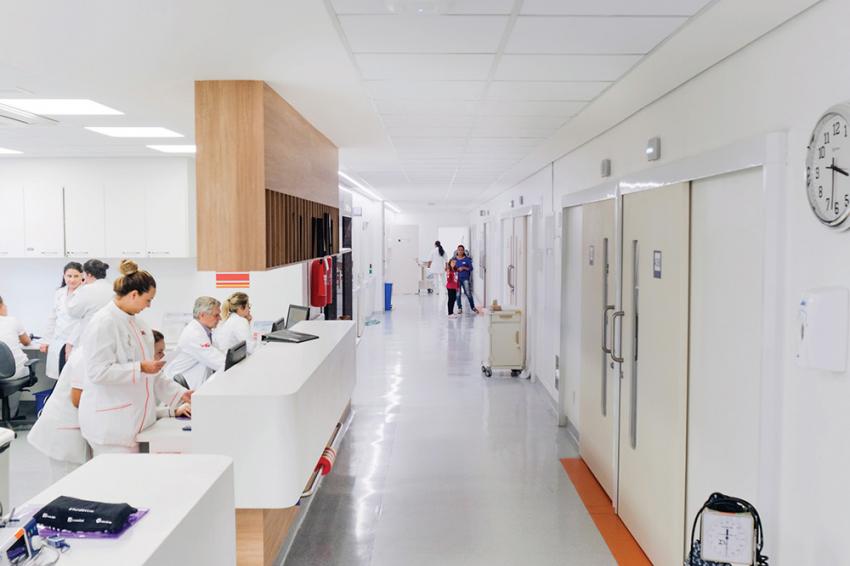No Touch, No Problem: How QR Codes Add Benefits to Access Control
08.07.2021 - While QR codes aren’t new, it’s fair to say that 2020 became the comeback year for this technology. Be it the replacement of paper menus with QR codes on tables, which guests could scan to get a virtual menu on their mobile device, touchless payment options, or access control solutions that allow contactless visitor management – the global pandemic put contactless technology back in the spotlight. What also came into focus was the healthcare industry, that had to suddenly adjust to the new situation – probably more than any other industry. In the attempt of keeping people healthy and safe that’s when these two sectors crossed – because access control (specifically with QR code systems) played an interesting role for healthcare establishments.
Given the initial uncertainty of how the virus was spreading, it’s understandable that people want to minimize contact with surfaces, including doorknobs and handles (and were told to do so). Adding QR to the access control solutions provides not only a more hygienic way of opening a door – it also comes with an extra layer of security, flexibility and scalability in visitor management applications. Features that are useful for many industries – from offices to the healthcare sector.
QR Codes and Visitor Access – How Does it Work?
The principles behind QR codes in access control systems are similar to other use cases: It’s an interplay of the information that’s saved in the QR code and a camera that can read the code.
In access control solutions, the visitor credentials are saved in the QR code, which is submitted to the individual’s device. The camera on a network intercom mounted at the door acts as a reader to provide those credentials to a network door controller, which can access and identify the associated validity date and time for those credentials. If the information in the system matches the ones in the code, access to the specific area or building is granted.
It adds a layer of additional security in not solely relying on someone checking a schedule to grant access (which can leave room for human error). Where it’s particularly useful is in establishments that have a high visitor flow, or that include restricted areas that are only accessible with the respective authorization (which comes with the QR code).
Another impactful benefit of QR code-based systems is that they’re free to issue, and easy to personalize for a temporary amount of time, as opposed to handing out RFID cards which are expensive, easy to lose, and more time-consuming to issue. This is particularly interesting for establishments with a limited budget for procurement and maintenance, such as hospitals or universities.
More Flexibility and Security no Matter the Time
Having QR codes and readers integrated in the access control system allows for more flexibility when it comes to visitor management as well as a better overview of who is visiting and when.
One example, where adding QR code readers provided a secure, yet flexible visitor management solution for a complex access setting, was at a digital start-up centre in Germany – the Einstein 1. It’s located at the campus of Hof University of Applied Sciences and consists of three different usage zones:
- One meeting area, that’s open to all students
- and entrepreneurs
- A co-working space, that’s only accessible for
- registered visitors but can be used 24/7
- The first floor, that houses 12 fully equipped start-up offices, including furniture, internet and telephone system, which can be rented by entrepreneurs and start-ups
Having all these different visitor groups and zones with various security and access requirement posed a challenge for the access and security regulation throughout the whole centre. By installing several door controllers, network cameras and implementing the QR code system, it is now possible for co-workers to rent, for example, a day pass online and get the temporary QR code sent to their mobile device. The code grants access to the booked space in the building but keeps the restricted areas locked. The arrival time can be adjusted online if necessary.
To separate the different visitor groups, students are set up to only get access during the opening times of the university, while entrepreneurs have unlimited access to the building (and additional key cards for the office rooms and elevators).
From a security perspective it’s also a useful way for security operators to track who actually entered the building at what time without having to go through hours of video footage. A feature that provides an overview of the number of visitors can be useful in case of an incident to trace back who was on the ground. The network surveillance cameras on-site could then be useful to identify individuals if needed.
With this combination of network cameras and intelligent access solutions, the different users are now able to enter as autonomously as possible, while ensuring that the hardware that start-ups store there is protected against theft.
Keeping People Safe and Healthy – The Importance of Access control in the Healthcare Sector
The Covid-19 pandemic and the fact that people want to keep the touchpoints to surfaces to a minimum applies nowhere more than in the healthcare industry, and in hospitals most critically of all.
When it comes to Covid-19 a single person can infect 2 to 4 people, according to the Joint Commission. After 5 transmission cycles, that could mean upwards of 345 people being infected. Replacing keypads with low touch access control like QR code readers to automatically open and shut doors can act as a force multiplier for healthcare facilities as it reduces the amount of shared contact points through which people can become infected.
Just like in the example of the start-up centre, visitors and employees would get a personalized QR code sent to their smartphone or other device that grants them access to the facilities and ensures nobody is entering areas they’re not authorized for, such as the ICU or storage rooms. Advanced access control systems also help keep track on the number of people in the building, and the time they spend there. This makes it easier to stick to the recommended number of people per square metre (according to the Covid-19 regulations).
Combining Access Control and Audio
It’s not just about reducing the number of touch points with the help of QR codes – access control can also be useful in different ways when combined with other devices. A network intercom, for example, could even play a pre-recorded message when prompted with the visitor scanning the QR code, reminding the visitor to wear a mask before they enter the building.
Another example of how combining access control solutions with audio could be used comes from the Martin Luther King, Jr. Community Hospital in Los Angeles. The facility blocked the card readers at the various entrances and used audio and messaging from intercoms to direct everyone to the main entrance. In this way visitors, employees, and vendors could be screened upon entry, ensuring everyone entering the building was healthy.
Advanced Access Control Today and Tomorrow
While many of these access control solutions – particularly when talking about the healthcare sector – are framed within the context of the pandemic, it’s important to note that the solutions can (and should) be used once this health crisis is over. Therefore, it’s key for any establishment to adopt it with the intention of it being a long-term solution.
As demonstrated with the German start-up centre, advanced access control such as QR code readers help to improve access management in different applications. Adding the low contact aspect contributes to a more efficient and sustainable approach, with reduced costs for maintaining cards and other physical solutions.
The Author: Paul Baratta, Healthcare Segment, Development Manager at Axis Communications











